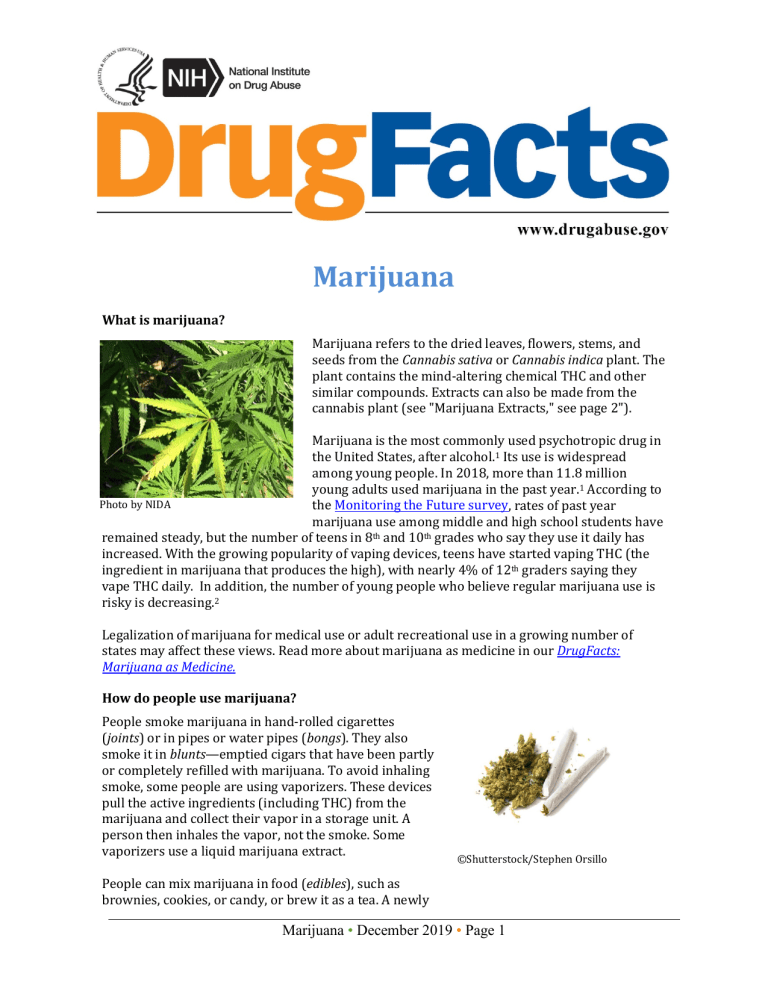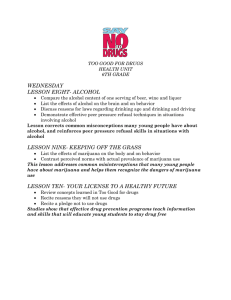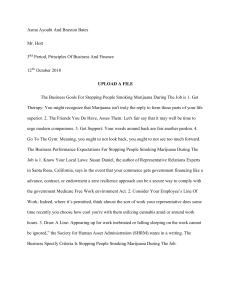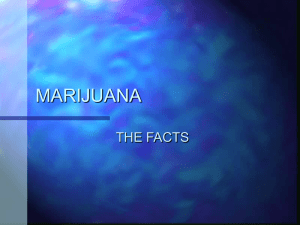
Marijuana What is marijuana? Marijuana refers to the dried leaves, flowers, stems, and seeds from the Cannabis sativa or Cannabis indica plant. The plant contains the mind-altering chemical THC and other similar compounds. Extracts can also be made from the cannabis plant (see "Marijuana Extracts," see page 2"). Marijuana is the most commonly used psychotropic drug in the United States, after alcohol.1 Its use is widespread among young people. In 2018, more than 11.8 million young adults used marijuana in the past year.1 According to Photo by NIDA the Monitoring the Future survey, rates of past year marijuana use among middle and high school students have remained steady, but the number of teens in 8th and 10th grades who say they use it daily has increased. With the growing popularity of vaping devices, teens have started vaping THC (the ingredient in marijuana that produces the high), with nearly 4% of 12th graders saying they vape THC daily. In addition, the number of young people who believe regular marijuana use is risky is decreasing.2 Legalization of marijuana for medical use or adult recreational use in a growing number of states may affect these views. Read more about marijuana as medicine in our DrugFacts: Marijuana as Medicine. How do people use marijuana? People smoke marijuana in hand-rolled cigarettes (joints) or in pipes or water pipes (bongs). They also smoke it in blunts—emptied cigars that have been partly or completely refilled with marijuana. To avoid inhaling smoke, some people are using vaporizers. These devices pull the active ingredients (including THC) from the marijuana and collect their vapor in a storage unit. A person then inhales the vapor, not the smoke. Some vaporizers use a liquid marijuana extract. People can mix marijuana in food (edibles), such as brownies, cookies, or candy, or brew it as a tea. A newly ©Shutterstock/Stephen Orsillo Marijuana • December 2019 • Page 1 popular method of use is smoking or eating different forms of THC-rich resins (see "Marijuana Extracts," see page 2). Marijuana Extracts Smoking THC-rich resins extracted from the marijuana plant is on the rise. People call this practice dabbing. These extracts come in various forms, such as: • hash oil or honey oil—a gooey liquid • wax or budder—a soft solid with a texture like lip balm • shatter—a hard, amber-colored solid These extracts can deliver extremely large amounts of THC to the body, and their use has sent some people to the emergency room. Another danger is in preparing these extracts, which usually involves butane (lighter fluid). A number of people have caused fires and explosions and have been seriously burned from using butane to make extracts at home.3,4 How does marijuana affect the brain? Marijuana has both short-and long-term effects on the brain. Short-Term Effects When a person smokes marijuana, THC quickly passes from the lungs into the bloodstream. The blood carries the chemical to the brain and other organs throughout the body. The body absorbs THC more slowly when the person eats or drinks it. In that case, they generally feel the effects after 30 minutes to 1 hour. THC acts on specific brain cell receptors that ordinarily react to natural THC-like chemicals. These natural chemicals play a role in normal brain development and function. Marijuana over activates parts of the brain that THC acts on numerous areas in the brain (in contain the highest number of these receptors. yellow). This causes the "high" that people feel. Other Image by NIDA effects include: • altered senses (for example, seeing brighter colors) • altered sense of time • changes in mood • impaired body movement • difficulty with thinking and problem-solving • impaired memory • hallucinations (when taken in high doses) • delusions (when taken in high doses) • psychosis (risk is highest with regular use of high potency marijuana) Marijuana • December 2019 • Page 2 Long-Term Effects Marijuana also affects brain development. When people begin using marijuana as teenagers, the drug may impair thinking, memory, and learning functions and affect how the brain builds connections between the areas necessary for these functions. Researchers are still studying how long marijuana's effects last and whether some changes may be permanent. For example, a study from New Zealand conducted in part by researchers at Duke University showed that people who started smoking marijuana heavily in their teens and had an ongoing marijuana use disorder lost an average of 8 IQ points between ages 13 and 38. The lost mental abilities didn't fully return in those who quit marijuana as adults. Those who started smoking marijuana as adults didn't show notable IQ declines.5 In another recent study on twins, those who used marijuana showed a significant decline in general knowledge and in verbal ability (equivalent to 4 IQ points) between the preteen years and early adulthood, but no predictable difference was found between twins when one used marijuana and the other didn't. This suggests that the IQ decline in marijuana users may be caused by something other than marijuana, such as shared familial factors (e.g., genetics, family environment).6 NIDA’s Adolescent Brain Cognitive Development (ABCD) study, a major longitudinal study, is tracking a large sample of young Americans from late childhood to early adulthood to help clarify how and to what extent marijuana and other substances, alone and in combination, affect adolescent brain development. Read more about the ABCD study on our Longitudinal Study of Adolescent Brain and Cognitive Development (ABCD Study) webpage. A Rise in Marijuana’s THC Levels The amount of THC in marijuana has been increasing steadily over the past few decades.7 For a person who's new to marijuana use, this may mean exposure to higher THC levels with a greater chance of a harmful reaction. Higher THC levels may explain the rise in emergency room visits involving marijuana use. The popularity of edibles also increases the chance of harmful reactions. Edibles take longer to digest and produce a high. Therefore, people may consume more to feel the effects faster, leading to dangerous results. Higher THC levels may also mean a greater risk for addiction if people are regularly exposing themselves to high doses. What are the other health effects of marijuana? Marijuana use may have a wide range of effects, both physical and mental. Physical Effects • Breathing problems. Marijuana smoke irritates the lungs, and people who smoke marijuana frequently can have the same breathing problems as those who smoke tobacco. These problems include daily cough and phlegm, more frequent lung illness, and a higher risk of lung infections. Researchers so far haven't found a higher risk for lung cancer in people who smoke marijuana.8 Marijuana • December 2019 • Page 3 • • • Increased heart rate. Marijuana raises heart rate for up to 3 hours after smoking. This effect may increase the chance of heart attack. Older people and those with heart problems may be at higher risk. Problems with child development during and after pregnancy. One study found that about 20% of pregnant women 24-years-old and younger screened positive for marijuana. However, this study also found that women were about twice as likely to screen positive for marijuana use via a drug test than they state in self-reported measures.9 This suggests that self-reported rates of marijuana use in pregnant females is not an accurate measure of marijuana use and may be underreporting their use. . Additionally, in one study of dispensaries, nonmedical personnel at marijuana dispensaries were recommending marijuana to pregnant women for nausea, but medical experts warn against it. This concerns medical experts because marijuana use during pregnancy is linked to lower birth weight10 and increased risk of both brain and behavioral problems in babies. If a pregnant woman uses marijuana, the drug may affect certain developing parts of the fetus's brain. Children exposed to marijuana in the womb have an increased risk of problems with attention,11 memory, and problemsolving compared to unexposed children.12 Some research also suggests that moderate amounts of THC are excreted into the breast milk of nursing mothers.13 With regular use, THC can reach amounts in breast milk that could affect the baby's developing brain. Other recent research suggests an increased risk of preterm births.27 More research is needed. Read our Marijuana Research Report for more information about marijuana and pregnancy. Intense nausea and vomiting. Regular, long-term marijuana use can lead to some people to develop Cannabinoid Hyperemesis Syndrome. This causes users to experience regular cycles of severe nausea, vomiting, and dehydration, sometimes requiring emergency medical attention.14 Reports of Deaths Related to Vaping The Food and Drug Administration has alerted the public to hundreds of reports of serious lung illnesses associated with vaping, including several deaths. They are working with the Centers for Disease Control and Prevention (CDC) to investigate the cause of these illnesses. Many of the suspect products tested by the states or federal health officials have been identified as vaping products containing THC, the main psychotropic ingredient in marijuana. Some of the patients reported a mixture of THC and nicotine; and some reported vaping nicotine alone. No one substance has been identified in all of the samples tested, and it is unclear if the illnesses are related to one single compound. Until more details are known, FDA officials have warned people not to use any vaping products bought on the street, and they warn against modifying any products purchased in stores. They are also asking people and health professionals to report any adverse effects. The CDC has posted an information page for consumers. Marijuana • December 2019 • Page 4 Mental Effects Long-term marijuana use has been linked to mental illness in some people, such as: • temporary hallucinations • temporary paranoia • worsening symptoms in patients with schizophrenia—a severe mental disorder with symptoms such as hallucinations, paranoia, and disorganized thinking Marijuana use has also been linked to other mental health problems, such as depression, anxiety, and suicidal thoughts among teens. However, study findings have been mixed. ©iStock/Adrian Hillman Are there effects of inhaling secondhand marijuana smoke? Failing a Drug Test? While it's possible to fail a drug test after inhaling secondhand marijuana smoke, it's unlikely. Studies show that very little THC is released in the air when a person exhales. Research findings suggest that, unless people are in an enclosed room, breathing in lots of smoke for hours at close range, they aren't likely to fail a drug test.15,16 Even if some THC was found in the blood, it wouldn't be enough to fail a test. Getting High from Passive Exposure? Similarly, it's unlikely that secondhand marijuana smoke would give nonsmoking people in a confined space a high from passive exposure. Studies have shown that people who don't use marijuana report only mild effects of the drug from a nearby smoker, under extreme conditions (breathing in lots of marijuana smoke for hours in an enclosed room).17 Other Health Effects? More research is needed to know if secondhand marijuana smoke has similar health risks as secondhand tobacco smoke. A recent study on rats suggests that secondhand marijuana smoke can do as much damage to the heart and blood vessels as secondhand tobacco smoke.20 But researchers haven't fully explored the effect of secondhand marijuana smoke on humans. What they do know is that the toxins and tar found in marijuana smoke could affect vulnerable people, such as children or people with asthma. Is marijuana a gateway drug? Use of alcohol, tobacco, and marijuana are likely to come before use of other drugs.21,22 Animal studies have shown that early exposure to addictive How Does Marijuana Affect a Person's Life? Compared to those who don't use marijuana, those who frequently use large amounts report the following: • lower life satisfaction • poorer mental health • poorer physical health • more relationship problems People also report less academic and career success. For example, marijuana use is linked to a higher likelihood of dropping out of school.18 It's also linked to more job absences, accidents, and injuries.19 Marijuana • December 2019 • Page 5 substances, including THC, may change how the brain responds to other drugs. For example, when rodents are repeatedly exposed to THC when they're young, they later show an enhanced response to other addictive substances—such as morphine or nicotine—in the areas of the brain that control reward, and they're more likely to show addiction-like behaviors.23,24 Although these findings support the idea of marijuana as a "gateway drug," the majority of people who use marijuana don't go on to use other "harder" drugs. It's also important to note that other factors besides biological mechanisms, such as a person’s social environment, are also critical in a person’s risk for drug use and addiction. Read more about marijuana as a gateway drug in our Marijuana Research Report. Can a person overdose on marijuana? An overdose occurs when a person uses enough of the drug to produce life-threatening symptoms or death. There are no reports of teens or adults dying from marijuana alone. However, some people who use marijuana can feel some very uncomfortable side effects, especially when using marijuana products with high THC levels. People have reported symptoms such as anxiety and paranoia, and in rare cases, an extreme psychotic reaction (which can include delusions and hallucinations) that can lead them to seek treatment in an emergency room. While a psychotic reaction can occur following any method of use, emergency room responders have seen an increasing number of cases involving marijuana edibles. Some people (especially preteens and teens) who know very little about edibles don't realize that it takes longer for the body to feel marijuana’s effects when eaten rather than smoked. So they consume more of the edible, trying to get high faster or thinking they haven't taken enough. In addition, some babies and toddlers have been seriously ill after ingesting marijuana or marijuana edibles left around the house. Is marijuana addictive? Marijuana use can lead to the development of a substance use disorder, a medical illness in which the person is unable to stop using even though it's causing health and social problems in their life. Severe substance use disorders are also known as addiction. Research suggests that between 9 and 30 percent of those who use marijuana may develop some degree of marijuana use disorder.25 People who begin using marijuana before age 18 are four to seven times more likely than adults to develop a marijuana use disorder.26 Many people who use marijuana long term and are trying to quit report mild withdrawal symptoms that make quitting difficult. These include: • grouchiness • sleeplessness • decreased appetite • anxiety • cravings What treatments are available for marijuana use disorder? No medications are currently available to treat marijuana use disorder, but behavioral support has been shown to be effective. Examples include therapy and motivational incentives (providing Marijuana • December 2019 • Page 6 rewards to patients who remain drug-free). Continuing research may lead to new medications that help ease withdrawal symptoms, block the effects of marijuana, and prevent relapse. Points to Remember • • • • • • • • • • • Marijuana refers to the dried leaves, flowers, stems, and seeds from the Cannabis sativa or Cannabis indica plant. The plant contains the mind-altering chemical THC and other related compounds. People use marijuana by smoking, eating, drinking, or inhaling it. Smoking and vaping THC-rich extracts from the marijuana plant (a practice called dabbing) is on the rise. THC overactivates certain brain cell receptors, resulting in effects such as: o altered senses o changes in mood o impaired body movement o difficulty with thinking and problem-solving o impaired memory and learning Marijuana use can have a wide range of health effects, including: o hallucinations and paranoia o breathing problems o possible harm to a fetus's brain in pregnant women The amount of THC in marijuana has been increasing steadily in recent decades, creating more harmful effects in some people. It's unlikely that a person will fail a drug test or get high from passive exposure by inhaling secondhand marijuana smoke. There aren’t any reports of teens and adults dying from using marijuana alone, but marijuana use can cause some very uncomfortable side effects, such as anxiety and paranoia and, in rare cases, extreme psychotic reactions. Marijuana use can lead to a substance use disorder, which can develop into an addiction in severe cases. No medications are currently available to treat marijuana use disorder, but behavioral support can be effective. Learn More For more information about marijuana and marijuana use, visit our: • Marijuana webpage • Drugged Driving DrugFacts This publication is available for your use and may be reproduced in its entirety without permission from NIDA. Citation of the source is appreciated, using the following language: Source: National Institute on Drug Abuse; National Institutes of Health; U.S. Department of Health and Human Services. Updated December 2019 Marijuana • December 2019 • Page 7 References 1. 2. 3. 4. 5. 6. 7. 8. 9. Substance Abuse Center for Behavioral Health Statistics and Quality. Results from the 2018 National Survey on Drug Use and Health: Detailed Tables. SAMHSA. https://www.samhsa.gov/data/report/2018-nsduh-detailed-tables Accessed December 2019. Johnston L, O’Malley P, Miech R, Bachman J, Schulenberg J. Monitoring the Future National Survey Results on Drug Use: 1975-2015: Overview: Key Findings on Adolescent Drug Use. Ann Arbor, MI: Institute for Social Research, The University of Michigan; 2015. Bell C, Slim J, Flaten HK, Lindberg G, Arek W, Monte AA. Butane Hash Oil Burns Associated with Marijuana Liberalization in Colorado. J Med Toxicol Off J Am Coll Med Toxicol. 2015;11(4):422-425. doi:10.1007/s13181-0150501-0 Romanowski KS, Barsun A, Kwan P, et al. Butane Hash Oil Burns: A 7-Year Perspective on a Growing Problem. J Burn Care Res Off Publ Am Burn Assoc. 2017;38(1):e165-e171. doi:10.1097/BCR.0000000000000334 Meier MH, Caspi A, Ambler A, et al. Persistent cannabis users show neuropsychological decline from childhood to midlife. Proc Natl Acad Sci U S A. 2012;109(40):E2657-E2664. doi:10.1073/pnas.1206820109 Jackson NJ, Isen JD, Khoddam R, et al. Impact of adolescent marijuana use on intelligence: Results from two longitudinal twin studies. Proc Natl Acad Sci U S A. 2016;113(5):E500-E508. doi:10.1073/pnas.1516648113 Mehmedic Z, Chandra S, Slade D, et al. Potency trends of Δ9-THC and other cannabinoids in confiscated cannabis preparations from 1993 to 2008. J Forensic Sci. 2010;55(5):1209-1217. doi:10.1111/j.1556-4029.2010.01441.x National Academies of Sciences, Engineering, and Medicine. The Health Effects of Cannabis and Cannabinoids: Current State of Evidence and Recommendations for Research. Washington, DC: The National Academies Press; 2017. Young-Wolff KC, Tucker L-Y, Alexeeff S, et al. Trends in Self-reported and Biochemically Tested Marijuana Use Among Pregnant Females in California From 2009-2016. JAMA. 2017;318(24):2490. doi:10.1001/jama.2017.17225 10. The National Academies of Sciences, Engineering, and Medicine, Health and Medicine Division, Board on Population Health and Public Health Practice, Committee on the Health Effects of Marijuana: An Evidence Review and Research Agenda. The Health Effects of Cannabis and Cannabinoids: The Current State of Evidence and Recommendations for Research. http://nationalacademies.org/hmd/Reports/2017/health-effects-of-cannabis-and-cannabinoids.aspx. Accessed January 19, 2017. 11. Goldschmidt L, Day NL, Richardson GA. Effects of prenatal marijuana exposure on child behavior problems at age 10. Neurotoxicol Teratol. 2000;22(3):325-336. 12. Richardson GA, Ryan C, Willford J, Day NL, Goldschmidt L. Prenatal alcohol and marijuana exposure: effects on neuropsychological outcomes at 10 years. Neurotoxicol Teratol. 2002;24(3):309-320. 13. Perez-Reyes M, Wall ME. Presence of delta9-tetrahydrocannabinol in human milk. N Engl J Med. 1982;307(13):819820. doi:10.1056/NEJM198209233071311 14. Galli JA, Sawaya RA, Friedenberg FK. Cannabinoid Hyperemesis Syndrome. Curr Drug Abuse Rev. 2011;4(4):241-249. 15. Röhrich J, Schimmel I, Zörntlein S, et al. Concentrations of delta9-tetrahydrocannabinol and 11-nor-9carboxytetrahydrocannabinol in blood and urine after passive exposure to Cannabis smoke in a coffee shop. J Anal Toxicol. 2010;34(4):196-203. 16. Cone EJ, Bigelow GE, Herrmann ES, et al. Non-smoker exposure to secondhand cannabis smoke. I. Urine screening and confirmation results. J Anal Toxicol. 2015;39(1):1-12. doi:10.1093/jat/bku116 Marijuana • December 2019 • Page 8 17. Herrmann ES, Cone EJ, Mitchell JM, et al. Non-smoker exposure to secondhand cannabis smoke II: Effect of room ventilation on the physiological, subjective, and behavioral/cognitive effects. Drug Alcohol Depend. 2015;151:194202. doi:10.1016/j.drugalcdep.2015.03.019 18. McCaffrey DF, Pacula RL, Han B, Ellickson P. Marijuana Use and High School Dropout: The Influence of Unobservables. Health Econ. 2010;19(11):1281-1299. doi:10.1002/hec.1561 19. Zwerling C, Ryan J, Orav EJ. The efficacy of preemployment drug screening for marijuana and cocaine in predicting employment outcome. JAMA. 1990;264(20):2639-2643. 20. Wang X, Derakhshandeh R, Liu J, et al. One Minute of Marijuana Secondhand Smoke Exposure Substantially Impairs Vascular Endothelial Function. J Am Heart Assoc. 2016;5(8). doi:10.1161/JAHA.116.003858 21. Secades-Villa R, Garcia-Rodríguez O, Jin CJ, Wang S, Blanco C. Probability and predictors of the cannabis gateway effect: a national study. Int J Drug Policy. 2015;26(2):135-142. doi:10.1016/j.drugpo.2014.07.011 22. Levine A, Huang Y, Drisaldi B, et al. Molecular mechanism for a gateway drug: epigenetic changes initiated by nicotine prime gene expression by cocaine. Sci Transl Med. 2011;3(107):107ra109. doi:10.1126/scitranslmed.3003062 23. Panlilio LV, Zanettini C, Barnes C, Solinas M, Goldberg SR. Prior exposure to THC increases the addictive effects of nicotine in rats. Neuropsychopharmacol Off Publ Am Coll Neuropsychopharmacol. 2013;38(7):1198-1208. doi:10.1038/npp.2013.16 24. Cadoni C, Pisanu A, Solinas M, Acquas E, Di Chiara G. Behavioural sensitization after repeated exposure to Delta 9tetrahydrocannabinol and cross-sensitization with morphine. Psychopharmacology (Berl). 2001;158(3):259-266. doi:10.1007/s002130100875 25. Hasin DS, Saha TD, Kerridge BT, et al. Prevalence of Marijuana Use Disorders in the United States Between 20012002 and 2012-2013. JAMA Psychiatry. 2015;72(12):1235-1242. doi:10.1001/jamapsychiatry.2015.1858 26. Winters KC, Lee C-YS. Likelihood of developing an alcohol and cannabis use disorder during youth: association with recent use and age. Drug Alcohol Depend. 2008;92(1-3):239-247. doi:10.1016/j.drugalcdep.2007.08.005 27. Corsi DJ, Walsh L, Weiss D, et al. Association Between Self-reported Prenatal Cannabis Use and Maternal, Perinatal, and Neonatal Outcomes. JAMA. Published online June 18, 2019322(2):145–152. doi:10.1001/jama.2019.8734 Marijuana • December 2019 • Page 9





